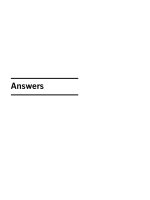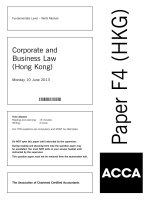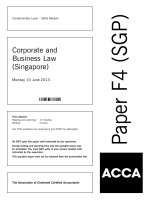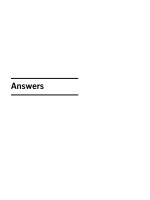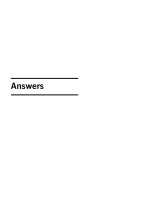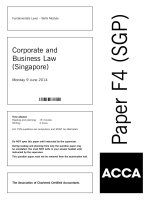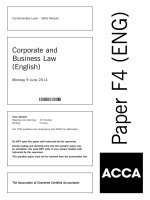Acca f4 corporate and business law singapore section b 2015 jun questions
Bạn đang xem bản rút gọn của tài liệu. Xem và tải ngay bản đầy đủ của tài liệu tại đây (64.76 KB, 4 trang )
Corporate and
Business Law
(Singapore)
Monday 8 June 2015
Time allowed: 2 hours
This paper is divided into two sections:
Section A – ALL 45 questions are compulsory and MUST be
attempted
Section B – ALL FIVE questions are compulsory and MUST be
attempted
Do NOT open this paper until instructed by the supervisor.
You must NOT write in your answer booklet until instructed by the
supervisor.
Do NOT record any of your answers on the exam paper.
This question paper must not be removed from the examination hall.
The Association of Chartered Certified Accountants
Paper F4 (SGP)
Fundamentals Level – Skills Module
Section B – ALL FIVE questions are compulsory and MUST be attempted
Please write your answers to all parts of these questions on the lined pages within the Candidate Answer Booklet.
1
Eric is setting up a management consultancy business and wants to have a website for his business. Eric made an
appointment to meet Belle, a freelance web designer. Belle told Eric that she had designed the websites of several
famous management consultancy companies. Upon hearing this, Eric was impressed which prompted him to
immediately sign a contract with Belle, even though he felt that her fee of $10,000 was a bit high.
A few days later, Eric was speaking to a friend who happened to know Belle. Eric found out that Belle’s statement
that she had designed the websites of several famous management companies was untrue. Eric called Belle to say
he no longer wanted her to design the website. Belle said it was too late because she had already done some work
on the website.
Required:
(a) Explain why Belle’s statement that she had designed the websites of several famous management companies
may be an actionable misrepresentation.
(3 marks)
(b) State the type of misrepresentation Belle may have made, and the remedies Eric is likely to obtain.
(3 marks)
(6 marks)
2
Ann, Bill and Carl agreed to be partners and set up Big Fun to carry on the business of selling home entertainment
products. Their friend, Dan, agreed that in return for $5,000, he would stand as guarantor to enable the three of them
to take a $200,000 loan from the bank. Dan said he would not be involved in the business in any other way. Carl
later had an argument with Ann and Bill and left Big Fun in March 2015.
Dan had boasted to his friend, Ryan, that he was a partner of Big Fun. Ryan was a distributor of speakers and he
had entered into a contract on cash terms with Big Fun when Big Fun was first set up in 2014. As Dan came from
a wealthy family and claimed to be a partner of Big Fun, Ryan entered into a second contract in April 2015 pursuant
to which Ryan sold speakers to Big Fun on credit terms. Ryan was not aware that Carl had just left Big Fun. Big Fun
subsequently failed to pay Ryan.
Required:
Explain whether Ryan can sue the following parties and claim from them the amount which Big Fun owed him:
(a) Ann and Bill;
(2 marks)
(b) Carl;
(2 marks)
(c) Dan.
(2 marks)
(6 marks)
13
[P.T.O.
3
Soh Cables Pte Ltd (SC) was in financial difficulties. Soh, the chief executive officer and director of SC, had arranged
to sell a one-year-old machine to a company called Supreme Pte Ltd (Supreme) for $100,000. Soh knew the machine
could raise $150,000 on the market.
Supreme’s sole shareholder and sole director was Soh’s wife. The other two directors of SC, Pek and Woo, had
approved the sale of the machine to Supreme because Soh had told them $100,000 was a good price to sell the
machine and raise the cash required to tide over SC’s financial difficulties. They did not ask Soh any questions
regarding the sale of the machine. They also did not know of Soh’s connection with Supreme.
Required:
Explain the common law and statutory duties which the following parties may have breached as directors of SC:
(a) Soh;
(4 marks)
(b) Pek and Woo.
(2 marks)
(6 marks)
4
Mark, Nancy and Peter set up Progress Pte Ltd (Progress). Each of them hold 1,000 shares and are also directors of
Progress. There is an understanding between them that they will all participate in management and share equally in
the profits of the business. They choose not to pay dividends and instead take profits as directors’ fees.
Mark and Nancy argued with Peter and combined their votes to remove Peter as director. Peter received no income
following his removal as a director.
Required:
(a) Explain whether Peter will succeed in obtaining relief from the court pursuant to TWO provisions under the
Companies Act Cap 50.
(4 marks)
(b) State ONE remedy which Peter is likely to obtain pursuant to each of the TWO statutory provisions under
the Companies Act Cap 50.
(2 marks)
(6 marks)
14
5
Juniper Pte Ltd (Juniper) is in financial difficulties. The board of directors believes that Juniper’s troubles are
temporary and can be rescued by implementing a scheme of arrangement with its creditors. The board of directors
wishes to retain control of Juniper during the time it undergoes corporate rescue.
Juniper has one secured creditor, Easy Bank, and 20 unsecured creditors. Juniper owes Easy Bank $5m and
$100,000 to each of the 20 unsecured creditors. Under the proposed scheme of arrangement, Easy Bank will be
placed on its own in one class of creditors and the 20 unsecured creditors will be placed together in another class of
creditors.
Easy Bank and 10 of the unsecured creditors are in favour of the scheme of arrangement while the remaining 10 of
the unsecured creditors are against the scheme of arrangement.
Required:
(a) Explain why Juniper will opt for a scheme of arrangement instead of judicial management.
(2 marks)
(b) For the purposes of classification of creditors under the scheme of arrangement, explain why Easy Bank is
placed in a different class from the 20 unsecured creditors.
(2 marks)
(c) Explain whether the support of Easy Bank and 10 of the unsecured creditors will ensure the approval of the
scheme of arrangement under the Companies Act Cap 50.
(2 marks)
(6 marks)
End of Question Paper
15

